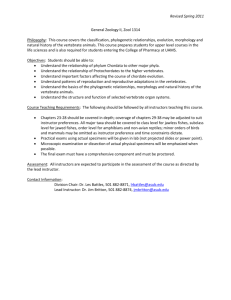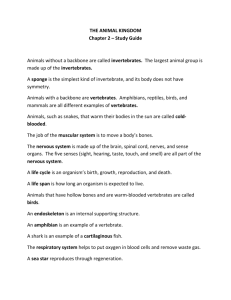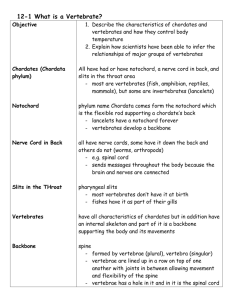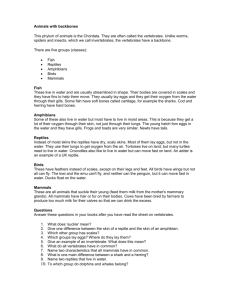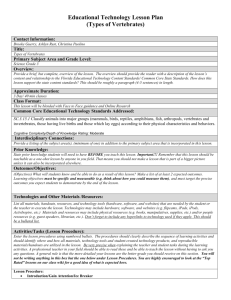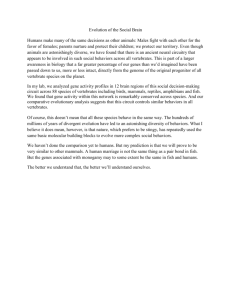study guide ch 36 answers
advertisement
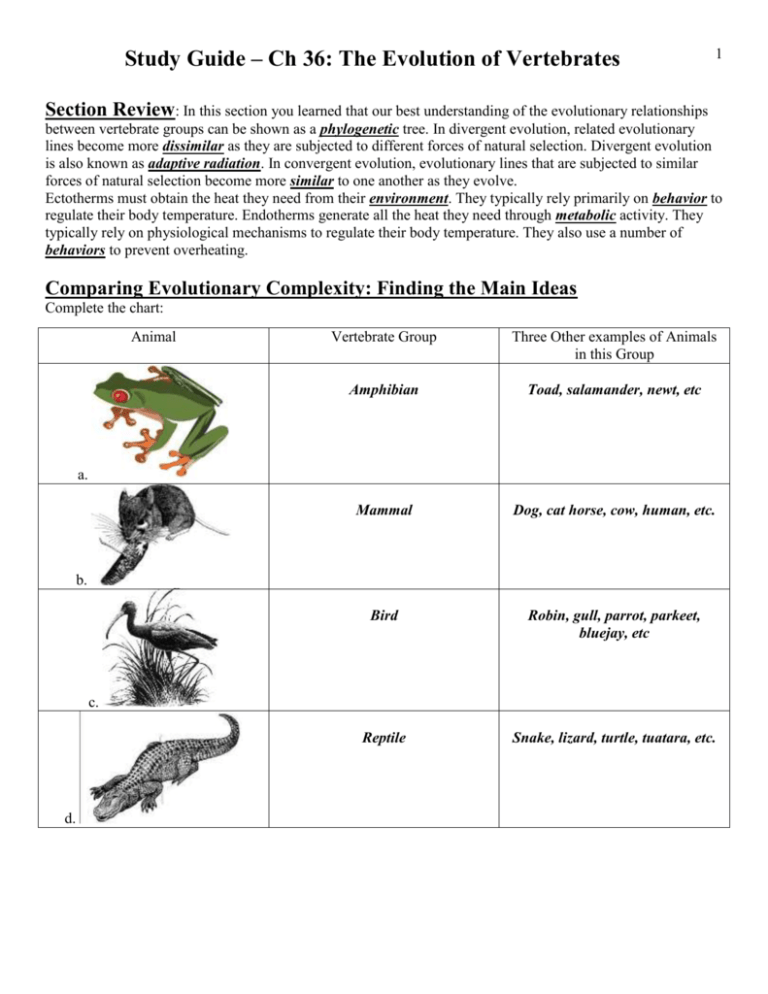
Study Guide – Ch 36: The Evolution of Vertebrates 1 Section Review: In this section you learned that our best understanding of the evolutionary relationships between vertebrate groups can be shown as a phylogenetic tree. In divergent evolution, related evolutionary lines become more dissimilar as they are subjected to different forces of natural selection. Divergent evolution is also known as adaptive radiation. In convergent evolution, evolutionary lines that are subjected to similar forces of natural selection become more similar to one another as they evolve. Ectotherms must obtain the heat they need from their environment. They typically rely primarily on behavior to regulate their body temperature. Endotherms generate all the heat they need through metabolic activity. They typically rely on physiological mechanisms to regulate their body temperature. They also use a number of behaviors to prevent overheating. Comparing Evolutionary Complexity: Finding the Main Ideas Complete the chart: Animal Vertebrate Group Three Other examples of Animals in this Group Amphibian Toad, salamander, newt, etc Mammal Dog, cat horse, cow, human, etc. Bird Robin, gull, parrot, parkeet, bluejay, etc Reptile Snake, lizard, turtle, tuatara, etc. a. b. c. d. Study Guide – Ch 36: The Evolution of Vertebrates Comparing Evolutionary Trends: Building Vocabulary Skills 2 The charge below lists tow general evolutionary trends. In the spaces provided, describe and give examples of each trend. Evolutionary Trend Description Examples Ex. Ocelot (placental) and quoll Adaptive radiation among (marsupial) are both spooted Convergent different groups of organisms catlike carnivores; flying squirrel produce species that are similar in (placental) and squirrel glider appearance and behavior. (marsupial) are both gliding herbivores that live in trees; groundhog (placental) and wombat (marsupial) are both stocky burrowing herbivores; giant anteater (placental) and numbat (marsupial) are both adapted for feeding on ants and termites. Ex. Therapsids gave rise to One species give rise to many monotremes, placentals and species that appear different marsupials; thecodonts gave rise externally but are similar to crocodilians and birds; early Divergent internally. jawed fishes gave rise to sharks, rays and some bony fishes; Darwin’s finches are all descended from a single ancestral species. Concept Mapping: Consider the concepts presented in Section 36-1 and how you would organize them into a concept map. Now look at the concept map for Chapter 36 at the end of this package. Notice that the map has been started for you. Add the key facts and concepts you fell are important for Section 36-1. When you have finished the chapter, you will have a completed concept map. Section 36-2: Form and Function in Vertebrates Section Review: In this section you learned that as you move through the vertebrate classes from fishes to mammals, organ systems tend to become increasingly complex. In more primitive vertebrates, the limbs stick out from the sides of the body. In more advanced vertebrates, the limbs tend to be positioned directly beneath the body. The digestive systems of vertebrates are adapted to a number of different foods and methods of feeding. Some vertebrates use gills for respiration; others use lungs. Lungs increase in efficiency as you move from amphibians to reptiles to mammals. Birds have the most advanced respiratory system of all vertebrates. Vertebrates that have a single-loop circulatory system also have a two-chambered heart. Double-loop circulatory systems are associated with lungs. As vertebrates with lungs evolved, the separation of the two loops of the circulatory system improved. Frogs and toads have a three-chambered heart. Most reptiles have a three-chambered heart that has partial partition in the ventricle. Birds, mammals, and crocodiles have a four- Study Guide – Ch 36: The Evolution of Vertebrates chambered heart. Most fishes and aquatic amphibians excrete nitrogenous wastes in the form of ammonia. Mammals and most cartilaginous fishes excrete urea. Birds and reptiles excrete uric acid. As you move through the vertebrate classes from fishes to mammals, the relative size and complexity of the cerebrum and cerebellum increase. Primitive vertebrates tend to have external fertilization; more advanced vertebrates tend to have internal fertilization. Vertebrates may be oviparous, ovoviviparous, or viviparous. Identifying Internal Structures: Building Vocabulary Skills The drawings below represent the digestive systems of different classes of vertebrates. Identify each of the numbered parts in the spaces provided on the following page. 1. Esophagus 2. Crop 3. Stomach 4. Gizzard 5. Cecum 6. Intestine 7. Liver 8. Gall Bladder 9. Pancreas 10. Cloaca 11. Rectum Comparing Vertebrate Characteristics Using the following list of characteristics, fill in the chart below (on the next page). Hops: has four legs Has six legs; walks; flies Lays soft-shelled eggs on land Walks and runs on four legs Insects, worms, berries, seeds Small mollusks, worms, small crabs Deserts; forests Produces live young Wooded or bushy areas Crawls on belly Pollen and nectar Queen lays thousands of eggs Lays eggs in water Lizards, insects, small snakes, Flies; walks on two legs rodents Swims using fins Fields; flower gardens Lays hard-shelled eggs in a nest Ponds, marshes, streams Rats, mice rabbits, squirrels Trees Salt water or fresh water Lays eggs in water Insects; spiders 3 Study Guide – Ch 36: The Evolution of Vertebrates Animal Movement Hops: has four legs Reproduction Lays eggs in water Food Insects; spiders Flies; walks on two legs Swims using fins Lays hard-shelled eggs in a nest Lays eggs in water Has six legs; walks; flies Crawls on belly Queen lays thousands of eggs Lays soft-shelled eggs on land Insects, worms, berries, seeds Small mollusks, worms, small crabs Pollen and nectar Walks and runs on four legs Produces live young Bullfrog Blackbird Flounder Honeybee Coral Snake Red Fox Lizards, insects, small snakes, rodents Rats, Mice, rabbits, squirrels 4 Habitat Ponds, marshes, streams Trees Salt water or fresh water Fields; flower gardens Deserts; forests Wooded or bushy areas Analyzing Vertebrate Adaptations Humans and other vertebrate land animals are adapted for living in air. Fishes are adapted for living in water. Fill in the chart below by comparing the adaptations that enable land vertebrates and fishes to perform various life processes. Life Process Getting Oxygen Moving Excretion Internal Transport Vertebrate Land Animals Amphibians use gills, lungs, and skin; reptiles, birds and mammals use lungs Fishes Use gills; some gulp air into their swim bladders Limbs or wings (modified forelimbs); legless amphibians and reptiles slither and/or burrow Nitrogenous wastes typically converted to more concentrated, less toxic forms such as urea and uric acid Double-loop circulatory system; heart partially or completely partitioned into three or four chambers Use fins and/or wavelike movements of the body Nitrogenous wastes can be excreted as ammonia because it is easily diluted and carried away by the surrounding water. Single-loop circulatory system; heart with two chambers 1. Explain why fishes need to be more streamlined than land animals. Fishes need to be streamlined in order to move quickly and easily through the water. Land animals moving through air do not need this adaptation. 2. Fishes are covered with a slimy material that is produced by glands in the skin. Suggest a reason for this covering. This slimy covering helps to waterproof the fishes and allows them to escape from predators more easily. Study Guide – Ch 36: The Evolution of Vertebrates 5 3. When a puffer fish is approached by a predator, it puffs itself up, causing its spines to stick out from its body. What land animals uses a similar form of protection? Porcupines and spiny anteaters also use this form of protection. 4. The moray eel is a fish that swims by wriggling its body. What land animal moves in a similar way? Snakes move with a wriggling motion. Identifying Internal Structures: Building Vocabulary Skills The drawing below represents the reproductive systems of several classes of vertebrates. Identify each of the numbered parts. 1. Testis 5. Sperm duct 2. Cloaca 6. Shell gland 3. Ovary 7. Urethra 4. Oviduct 8. Uterus Concept Mapping: Consider the concepts presented in Section 36-2 and how you would organize them into a concept map. Now look at the concept map for Chapter 36 at the end of this package. Notice that the map has been started for you. Add the key facts and concepts you fell are important for Section 36-2. When you have finished the chapter, you will have a completed concept map. Study Guide – Ch 36: The Evolution of Vertebrates 6


